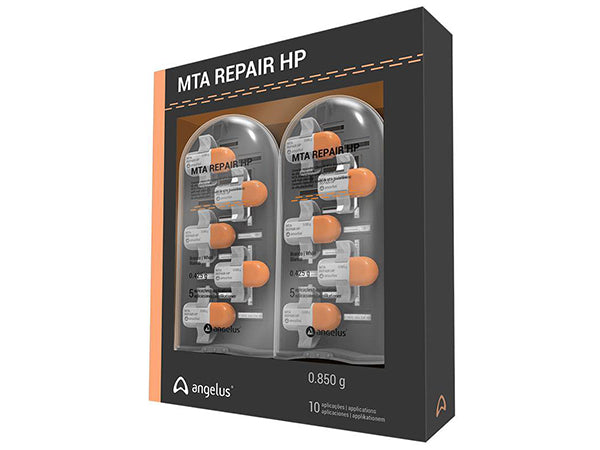



- Product Details
- Clinical Technique
- Videos
- Configurations
- FAQ
- Resources
MTA Repair HP is an endodontic bioceramic restorative cement that features higher plasticity, which makes it easier to manipulate and easier to insert into the dental cavity than traditional MTA. Other features and benefits include:
- Putty-like consistency for ideal handling and manipulation
- Fast setting time of 15 mins
- Contains radiopaquer Calcium Tungstate which prevents staining of root or crown
- Low solubility ensures prolonged action and quicker tissue healing
- High marginal sealing prevents the migration of microorganisms and fluids
- Excellent biological sealing of root perforation (canal and furcation) induces the formation of periradicular cement
- When used on pulp exposures induces the formation of a dentin barrier
- High alkalinity, prevents bacterial growth
- Composed of mineral oxides in the form of fine hydrophilic particles for use in humid conditions without a change in properties
- Powder and liquid in separate vials which both can be re-capped to prevent the product from deteriorating after initial usage
Indications for Use
- Treatment of root and furcation perforations
- Internal resorption and interior connections
- Retrofilling material for root end surgeries
- Pulp capping, pulpotomy/vital pulp therapy
- Apexification and apexigenesis

Drilling treatment using the new MTA Repair HP: Clinical Case Report
Prof. Dr. Fábio Duarte da Costa Aznar. Specialist in Endodontics HRAC (Centrinho)/USP/Bauru, Doctor of Applied Dental Sciences - Dental School by Bauru Q University of São Paulo, Coordinator of Specialization Course in Endodontics.
Female patient, 47 years old, presented with a clinical picture of extensive iatrogenic perforation of the furcation region of the dental element 36 (Figures I and II), associated with radiographic bone loss, vestibular fistula and pain on palpation. The patient-reported history of having been previously subjected to an urgent intervention in this tooth by other professionals, as it presented acute pain characteristic of pulpitis.
-
Figures I and II - Initial clinical and radiographic appearance of teeth 36. The tooth was submitted to endodontic therapy, and after the initial approach with the patient, anesthesia was given, followed by preparing absolute isolation. Subsequently, the coronary access was performed, where it was possible to clinically verify the presence of pulp necrosis and perforation. A disinfecting penetration of root canals (crown-down) was performed using as irrigator agent NaOCl to 5%, and the odontometry determined by the use of foraminal locator.

-
The preparation was carried out by Reciproc system (VDW/ Germany), and as irrigator agent was employed NaOCl 2.5% associated with ultrasonic activation performed with straight inserts (Irrisonic/Helse/Brazil).

-
Next, the drilling was treated, with its cleaning and the regularization, employing ultrasonic diamond insert (E7D/Helse/Brazil). As a complement to the intrachannel decontamination process and the furcation region, a biweekly exchange of Calcium Hydroxide (Ultracal/Ultradent/USA) was held, observing remission of all symptoms. The obturation was performed using the thermomechanical Hybrid Tagger technique (Figure III), by employing GutaCondensor (Maillefer/Switzerland), TP gutta-percha cones (Dentsply/Brazil) and MTAbased sealer Fillapex (Angelus/Brazil) (Figure IX). After thermo compaction, the obturation cutting was performed, as well as vertical condensation using cold pusher; and again the region of the perforation was cleaned and filled with Calcium Hydroxide.

-
Figure IV - Clinical and radiographic appearance of drilling filling with MTA Repair HP. After 15 days, again, we proceeded to seal the drilled region, and initially verified the proper possibility of drying the area. The filling of the drilled region was carried out with the use of MTA Repair HP (Angelus/ Brazil), previously prepared as recommended by the manufacturer, and it was inserted using an MTA Applicator (Angelus/Brazil). Clinical and radiographic criteria were used to determine the correct filling using the material (Figures IV and V); and the glass ionomer cement (Vitremer/3M/USA) used for the protection of the sealed region (Figure VI). After the temporary restoration, radiographically it was observed proper sealing of furcation region by MTA Repair HP, as well as no postoperative complications.

-
Figure V - Clinical and radiographic appearance of drilling filling with MTA Repair HP.

-
Figure VI. Drilling region protection sealed with glass ionomer cement.

-
Figure VII. Follow-up X-ray after two months.

A clinical case of an endodontic treatment of a root resorption. The main concern is the irregular shape of the apical foramen. With an irregular foramen like this, a gutta-percha cone can't properly fit and filling with MTA is an alternative.
A demonstration of the proper mixing technique for Angelus MTA Repair HP.
MTA Repair HP Kit (Item Number: 851830) contains 10 powder capsules with 0.085 grams each & 10 vials of liquid.
Q: What is the difference between Angelus MTA and MTA Repair HP?
A: The difference is in the replacement of distilled water by a liquid that contains water and another organic plasticizer that gives the product high plasticity. The replacement of the radio-pacifier (from Bismuth Oxide to Calcium Tungstate), ensuring the absence of dental discoloration.
Q: What is MTA?
A: MTA, is a bioactive material that induces the healing of periapical lesions, stimulates the formation of cementum, bone and, indirectly, periodontal ligament. It is the first material know in Endodontics which allows the growth of cementum layer directly from its surface.
View the MTA Repair HP Instructions for Use.
View the MTA Repair HP Product Sheet.
View the MTA Repair HP review in Inside Dentistry.
View the MTA Repair HP evaluation by Dental Product Shopper.
View article Endodontics: The Bioceramic Revolution - Materials and Methods, Part I by Dr. Douglas Harvey.
View the American Association of Endodontists (AAE) Position Statement on Vital Pulp Therapy.
